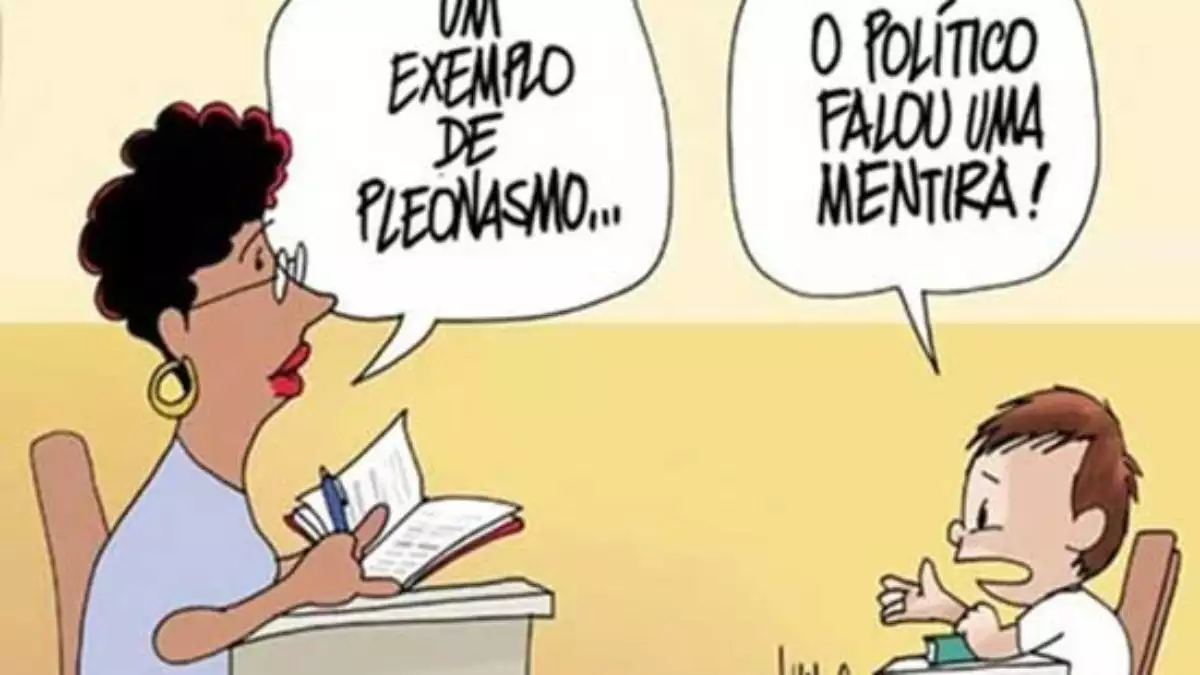THE pleonasmo é um recurso linguístico que muitas pessoas usam, mas que acaba gerando confusão na hora de se comunicar. Afinal, trata-se de repetir um termo ou uma ideia com intenção de dar mais ênfase na comunicação.
Inclusive, dependendo da forma com a qual o pleonasmo é utilizado, ele pode acabar se tornando um desvio da norma padrão, e se trata de um tipo de movimentação linguística que nem sempre é visto com bons olhos.
Conheça os tipos de pleonasmo
Pois bem, para conseguir identificar com mais compreensão esse formato de comunicação, é preciso ter em mente que existem alguns tipos de pleonasmo, como o literário e o vicioso. Para facilitar o entendimento, explicaremos um pouco mais sobre eles.
Começamos dizendo que eles são diferentes e dependem diretamente da intenção de quem está utilizando-os no discurso, seja durante uma fala sobre uma máquina de alinhamento ou em uma conversa casual com um amigo.
Alguns especialistas defendem que o uso dos termos que geram o pleonasmo pode acabar validando sua ocorrência, gerando assim uma figura de linguagem. Em outros casos, entretanto, ele se torna um vício de linguagem, que é prejudicial para a comunicação.

Pleonasmo Literário
No pleonasmo literário, a ideia é enfatizar um conceito, muitas vezes com a proposta de tornar uma construção de frase mais poética. Isso é muito comum em poemas que fazem referência à natureza, como uma forma de destacar parte da escrita.
Normalmente, este tipo de redundância é utilizado para destaque, criando assim uma referência estética mais direta e impactante ao texto, garantindo uma atenção maior a esse tipo de diálogo. Entre os principais exemplos, podemos citar:
- Sol quente;
- Mar azul;
- Noite preta;
- Neve branca.
Todos estes pleonasmos são básicos, mas costumam ser utilizados na linguagem como uma forma de dar um adjetivo especial que chame a atenção para a própria natureza do substantivo ao qual se refere.
Isso garante uma estrutura muito mais adequada ao tipo de diálogo que está sendo formado, que muitas vezes pode ser utilizado em conjunto com objetos pleonásticos.
Objetos Pleonásticos
Pois bem, neste caso, é possível dar realce a um objeto direto ou indireto, como uma válvula direcional, utilizando esta técnica. Ou seja, fazer uso de um complemento sobre a pesadora, mas que acabe sendo redundante.
Aliás, a repetição é uma importante ferramenta para destacar e apresentar um conteúdo mais qualificado ao longo de um texto ou diálogo, e esse tipo de ação acaba gerando objetos pleonásticos que podem garantir uma ênfase muito maior ao objeto em questão.
Pleonasmo Vicioso
Já no pleonasmo vicioso, não há uma necessidade de utilizar a técnica de maneira estética, criando assim um vício de linguagem, a redundância. Esse tipo de construção não acrescenta nada à frase original e pode até gerar confusão para o receptor da mensagem.
Por conta disso, os pleonasmos não costumam ser muito utilizados e, muitas vezes, são condenados na norma da língua ao escrever um material para uma empresa de advocacia ou, até mesmo, durante uma simples conversa.
Inclusive, se não há uma justificativa para o uso do pleonasmo, ele se torna um vício de linguagem, muitas vezes causado pela falta de conhecimento dos termos que estão sendo utilizados ou de como aplicá-los em um fraseamento correto.
Ainda assim, os pleonasmos são muito utilizados no dia a dia, seja por conta do hábito ou por falta de conhecimento. Algumas frases são tão populares que parecem um consenso comum, ainda que estejam gramaticalmente incorretas.
Por conta disso, é preciso ter atenção a esse tipo de diálogo, para garantir que você não utilize estes pleonasmos viciosos e acabe prejudicando sua comunicação, não se fazendo compreender com mais qualidade em suas ações.

Veja alguns pleonasmos que devem ser evitados
Alguns pleonasmos são muito populares, por conta disso muitas pessoas não sabem que estão os utilizando. Então, conhecer alguns desses pontos é um tipo de ação importante para você trabalhar com qualidade sua comunicação.
Esse tipo de ação ajuda a compreender melhor como você fala com os outros e até mesmo quando precisa utilizar a escrita, garantindo um diálogo mais adequado para suas interações com outras pessoas, seja para falar sobre calibração de termometro ou outro tema.
1 – Conclusão final
Muitas pessoas acabam usando esse termo para concluir textos e redações, mas esse tipo de pleonasmo gera redundância pelo fato de que a conclusão é uma palavra sinônima de final, portanto apenas uma das duas palavras já é o suficiente.
Esse tipo de erro é muito comum, uma vez que você acaba tentando dar uma ênfase maior ao fato de que o conteúdo está chegando em sua etapa final, e por isso deve ser identificado de maneira mais efetiva.
Outra forma comum de concluir um projeto ou trabalho é utilizando o termo “considerações finais”, e existe muita confusão na hora de escrita, o que acaba ocasionando mais utilizações do pleonasmo.
2 – Repetir de novo
Essa frase é muito utilizada, principalmente para pedir que uma pessoa repita pela segunda ou outra vez além da primeira repetição. Essa ênfase, normalmente, é para tentar dizer que mesmo com uma repetição, o entendimento não ficou claro para o receptor.
Embora seja um senso comum, e muitas pessoas consigam compreender a intenção do comunicador ao utilizar essa frase, seja para pedir a repetição do assunto sobre sensor de nível ou outro tema, está errado e acaba caindo no pleonasmo.
Repetir de novo, repetir outra vez ou suas variações, acaba sendo um modo de falar repetitivo, que não precisa se estender mais do que o necessário em um diálogo, por isso é importante saber utilizar sua comunicação.
Dessa forma, você consegue ter uma estrutura mais adequada para se comunicar com a outra pessoa, sem atrapalhar esse tipo de ação durante o tempo em que ambos passam conversando.
3 – Há muitos anos atrás
Quando há o interesse em comunicar uma questão de passagem de tempo, principalmente em um período muito anterior ao que está acontecendo o diálogo, é comum se utilizar o termo há muitos anos atrás.
Entretanto, o verbo haver já é uma identificação de tempo decorrido. Por conta disso, não há necessidade de afirmar que a frase está no passado, uma vez que a construção da sentença já indica que se trata de um elemento do passado.
Esse tipo de frase acaba se tornando repetitiva, o que torna a comunicação mais lenta e confusa para o receptor, devendo ser evitada sempre que possível.
Ou seja, quando você quiser falar que há muitos anos você tinha, por exemplo, uma cancela manual em casa, evite usar o ‘atrás’. Ou elimine o ‘há’, deixando a frase da seguinte forma: muitos anos atrás eu tive uma cancela manual na minha casa.
4 – Pequenos detalhes
Outra frase muito comum para a utilização no dia a dia, trata-se de uma repetição desnecessária, uma vez que em sua definição básica a palavra detalhe significa um pequeno elemento dentro de algo maior.
Por já se tratar de um pormenor do assunto no qual está sendo utilizado, não há a necessidade de utilizar um adjetivo para indicar que se trata de algo pequeno. Simplesmente dizer que a situação é um detalhe é mais do que suficiente.
5 – Consenso geral
As pessoas utilizam o termo consenso geral para indicar que há uma unanimidade em um determinado pensamento, ideia ou filosofia. Entretanto, um consenso já é a representação de concordância que a frase tem necessidade para indicar.
O consenso é uma decisão geral, baseada na opinião de um grupo de pessoas. Por conta disso, o consenso não precisa ser acompanhado do termo geral para conseguir apresentar qualidade em sua comunicação.
Esse tipo de ação é muito comum para tentar apresentar uma ideia como ampla e de boa aceitação, mas é importante ter em mente que você pode não precisar desse tipo de recurso para se fazer compreender com relação a seu material.
Em um exemplo prática, sua frase poderia ficar da seguinte forma: Já é um consenso que o tacógrafo digital vem sendo utilizado por diversas pessoas. Percebe? O geral é totalmente dispensável.
6 – Certeza absoluta
Este é outro uso comum dos pleonasmos viciosos, que muitas vezes é utilizado normalmente em uma conversa, tamanho o alcance de sua popularização. Embora o termo seja utilizado com o objetivo de demonstrar uma força maior na frase, está incorreto.
Isso acontece porque uma certeza é assertiva. Não há espaço para dúvidas quando você afirma que tem certeza de algo, então esse elemento é sempre absoluto, tirando assim a necessidade de utilizar o termo absoluta.
Uma certeza é a convicção de que você sabe o que está falando, o que garante mais segurança e indubitabilidade para a sentença como um todo.
Por exemplo, quando você diz: ‘tenho certeza que esses elementos de fixação são o suficiente’, você não precisa mais garantir com o ‘absoluta’.

Considerações finais
Os pleonasmos são uma ferramenta comum no dia a dia de cada pessoa, e por conta disso é preciso ficar atento para evitar utilizar esse tipo de construção de frase, garantindo assim uma comunicação mais direta e objetiva.
Utilizar termos que se repetem muito pode tornar sua comunicação pouco prática e até ter resultados e impactos negativos em seu ambiente pessoal ou profissional, o que faz a maioria das pessoas procurarem melhorar esse tipo de diálogo.
Esse texto foi originalmente desenvolvido pela equipe do blog Guia de Investimento, onde você pode encontrar centenas de conteúdos informativos sobre diversos segmentos.